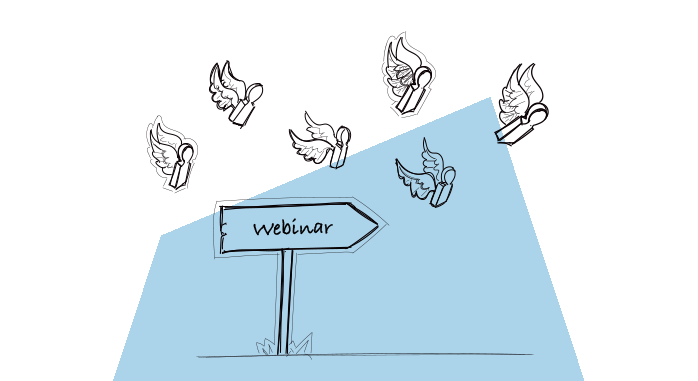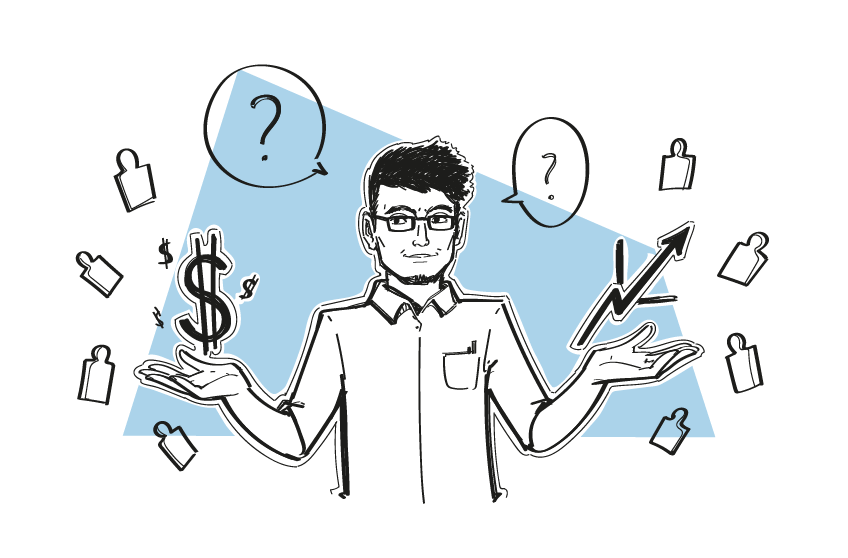You can get leads from two sources: inbound and outbound. But what’s actually the difference between the two when it comes to sales? How do you approach the leads from those two sources? Should you work out two different strategies for serving them? If so, how should the strategies differ? Keep reading to find the answers to those questions and convert more leads, both inbound and outbound, into customers.
Inbound and outbound leads – what’s the difference between them?
Inbound leads come to you. These are the people who come to your website, signup for the materials you put on your landing pages and blog, sign up for a trial or a demo. They find you and decide they want to interact with your content, service, and/or product(s).
Outbound leads are the ones you reach out to, usually via social media, cold email, or a cold call on the phone. They don’t know you yet, they haven’t seen your website, landing pages, blog, or other materials. They haven’t signed up for a trial or a demo. You find them and try to encourage them to interact with your content, and use your service and/or product(s).
From the sales perspective, the main difference between inbound and outbound leads is that they are at different stages of the buying cycle. Hence, they require different communication strategies from a sales rep.
In a nutshell:
An inbound lead
- not only acknowledges the existence of your brand but also has had some previous interaction with it;
- has some connotations with your brand and product;
- has done some research of the market you’re in;
- has some beliefs and expectations about your product;
- feels an urgent need to fix a problem he or she struggles with;
- is actively looking for a solution to the specific problem;
- has some specific questions about your product or service;
- all in all, has a wider context for your solution.
An outbound lead
- hasn’t had any interaction with your brand, and often does not even acknowledge its existence;
- hasn’t had any connotations with your brand and product/service;
- hasn’t necessarily done any research for a specific solution in your market lately;
- doesn’t have any beliefs or expectations about your product or service, is not aware of what the product does, or how the service works, and how exactly it might help them;
- may be aware of the problem, but doesn’t really feel an urgent need to fix it;
- most often isn’t actively looking for a solution at the moment;
- may have some general questions;
- all in all, doesn’t have a context for your solution.
Because the customer’s perspective differs between inbound and outbound leads, their buying processes will differ as well. The task of a salesperson is to match the sales activities, messaging, and general approach to the type of lead they are working with.
How to approach an inbound lead?
Be there for them
We often see companies that fully automate the service of their inbound leads. A personal approach in inbound sales is something you can rarely experience nowadays. Of course, it all depends on the scale of the lead influx, the particular product or service you’re offering, the size of your sales team, your focus and priorities of the company etc. But some personal touch will definitely help you convert more leads into customers – this I can tell you from our own experience at Woodpecker.
So even if you automate the customer onboarding process, make it as human-like as possible. And if you do have the time and resources to actually talk to your leads, definitely do that. This will also allow you to learn about their needs and expectations, and as a result, provide them with better customer service and, in a long term, with a better product.
Focus on helping, not selling
Whether you talk to your inbound leads or you send them automated sequences of messages, remember that the purpose of your communication should be helping them, not simply closing the deal as fast as you can. Inbound leads usually have a specific set of requirements for the product. Show them how the product can meet the requirements best.
As a salesperson, you know the product/service very well and you know how to present it to a potential customer so that they see the benefits of using it. Do that. Help them achieve their goals with your product, so they could actually feel the value you’re offering to them. Once they do, they will be eager to buy from you.
Be prepared for specific questions
If someone is in the process of looking for a specific solution to their problem, they may already have in mind a few expectations and ideas. While talking to you, they may ask you some specific questions in the context of those expectations and ideas. Be ready to answer those questions. Adopt their ideas as examples when explaining how your product or service works.
Sometimes the questions your inbound leads ask you may be quite technical. If you’re not sure how to answer such a question, just say it straight. Be honest. Get some time to find the answer, and get back to them as soon as you can.
Be up to date with your competitors
Because inbound leads have usually done some market research before they talk to you, they may have a list of very specific questions about the product or service you’re selling in comparison to other available solutions. Be prepared to answer those questions clearly because the answers your prospects get will help them make their buying decision.
Follow-up
Even if someone signed up for a trial or for a demo herself, it doesn’t mean she doesn’t need any attention from your side. Follow-ups after signup will allow you to start a human-to-human conversation, and then help you keep the relationship with your prospect warm and alive.
Your prospects, both inbound and outbound, will appreciate a human touch from the B2B company that’s trying to make a deal with them. Again, try not to be pushy in your follow-ups. Keep them useful and positive. Be persistent but also patient and polite.
Check how we approach inbound leads in Woodpecker:
How to approach an outbound lead?
Use storytelling to build some context
Because outbound leads haven’t had a chance to build a full context for your solution, you have to help them build the context. The best way to do that is to use storytelling. But it doesn’t mean you have to feed your prospects with fairytales about success devoid of any effort. Be honest.
Just use the descriptions of particular situations and processes that they can actually understand and refer to personally. Make them the characters of your story. If you’re explaining how your product or service works, place your explanation in the specific context of your customer. Outbound leads will not necessarily understand the use case if you tell them about general examples. They need specific examples set in their own unique context.
Focus on their particular use case
Don’t try to show them everything at once. You know all the great features your product or service offers to its users. But they do not have to be told about all the great features. In fact, try not to present the features, but talk about benefits instead. Again, focus on their specific use case and on the particular benefits they may gain from adopting your solution.
More on that approach in:
Features vs. Benefits – How to Present Your Product in a Cold Email?
Lead them step by step
When talking to an outbound lead, always propose them a next step to take. Make sure they know what to do next and when to do it. If they don’t feel an urgent need to solve a problem they have, their motivation may not be as strong after a week as it was a week before. That’s why it’s important to keep the onboarding process as easy for them as possible, and lead them by hand to the “aha moment,” when they realize the genuine value you’ve been promising them.
Outbound leads will hardly ever serve themselves. They require some more time from the sales reps, as the context for the sale needs to be built from scratch for them.
Check also:
Self-Service in Cold Email – What Shouldn’t We Expect from Our Addressees? >>
Follow-up
As you schedule the next step to take each time you talk to your outbound lead, the follow-up is necessary to have the prospect stick to the schedule. Remember that your follow-ups should be always helpful and positive. Don’t demand anything from the lead and don’t accuse them of anything. Persistence and politeness are key here.
Check out this episode of the Startup Chat with Steli Efti and Hiten Shah to learn more about the art of follow-up:
The Startup Chat Ep. 200: The Art of the Follow Up >>
Bonus: Tips for handling inbound and outbound sales
Use these insights to develop inbound marketing strategies and outbound marketing plans that resonate with your target audience:
- Inbound sales process: Focus on listening, addressing specific questions, and offering solutions relevant to the customer’s needs.
- Outbound sales techniques: Use storytelling, emphasize benefits, and guide prospective customers step by step to create context.
- Inbound call centers: Personalize responses and use follow-ups to strengthen relationships.
- Outbound call centers: Keep outgoing calls informative, tailored to their context, and always follow up.
- Ensure a smooth sales funnel experience for both inbound and outbound leads to boost conversions.
What’s in it for you?
The most important thing to remember is that there’s a significant difference between inbound & outbound leads. And because the two types of leads differ, it’s crucial to be prepared to serve them according to their perspective and the context they have, or haven’t, built before you talk to them.
If you message outbound leads the same way you message inbound leads, you may easily lose their interest, or worse – scare them off. And if you’re not prepared to talk to inbound leads about some technical details and answer their questions to their satisfaction, they may resign from your solution and choose your competitor instead.
Always try to focus your attention on listening to your prospect. Then refer to the information you hear, and adjust the way you communicate with them to the context they’ve built for themselves. If they haven’t built much context yet, help them do that. If they did, fit into this context and use it to present the solution you’re selling in the most relevant way possible.
Hope this will help you acknowledge the differences between inbound and outbound leads, and become more conscious of your specific sales activities.
Check also:
What to Do When You Get an Interested Reply to Your Cold Email? >>
Key Points to Remember
- Inbound and outbound sales have different communication needs.
- Inbound marketing focuses on attracting leads through content marketing and marketing strategies.
- Outbound marketing efforts like outbound calls and direct mail reach out to potential customers with no prior brand interaction.
- Sales representatives must adapt their approach to suit inbound leads or outbound marketing tactics.
- Customer relationship management plays a role in maintaining long-term engagement.
FAQ on differences between inbound & outbound
Check out the answers!
What is inbound sales?
Inbound sales involve engaging with leads who show interest in your brand by interacting with your content, signing up for trials, or browsing your website. These leads come to you, having already taken steps toward your solutions. Woodpecker can help manage and automate follow-up communications, ensuring that you maintain contact and nurture these leads through personalized email sequences.
What is an inbound vs outbound example?
An example of inbound sales is a lead signing up for a demo after reading your blog, indicating they are actively exploring your offerings. Conversely, outbound sales involve initiatives like using Woodpecker to send cold emails to potential customers who have not interacted with your brand, aiming to initiate that first engagement.
What is the difference between inbound and inside sales?
Inbound sales focus on nurturing leads who initiate contact with the business, usually through inbound calls or content marketing. Inside sales may include both inbound and outbound sales techniques, involving proactive outreach to prospective customers or responding to incoming calls from interested leads.
What is outbound sales?
Outbound sales involve sales reps actively contacting outbound leads using outbound calls, cold email, or direct mail. Outbound marketing efforts target a broader audience unfamiliar with the brand, aiming to convert these contacts into potential customers through personalized communication.
What is inbound marketing, and how does it support sales?
Inbound marketing focuses on attracting prospective customers by sharing valuable content. It encourages inbound calls and builds relationships through targeted inbound marketing strategies. These efforts guide leads through the sales funnel, supporting the inbound sales process by nurturing engagement and turning inquiries into sales opportunities.
READ ALSO

5 Ways a SaaS Sales Team Can Cooperate with Marketing for Better Lead Generation
Marketing and sales used to be portrayed in stark contrast. Nowadays, there's an ongoing trend to go for "sales and marketing alignment" -- that is, making the two teams work together. There's little information on how to do it exactly. Many focus on improving the flow of information between the two departments. Is that all that can be done? Today, I'll show you a couple of ways the Woodpecker marketing and sales teams cooperate to create a streamlined lead generation process.

How to Generate More Leads After a Webinar?
I'm sure you can agree that webinars are time-consuming and stressful. Not only do you have to carefully plan the whole thing out, but you also need to oversee a lot of things, such as recording & sound quality, take care of the Internet connection, plus you need to make sure there's enough space for everyone to attend the webinar.

6 Trends in Cold Email that Will Help You Get New Clients Abroad
We’re witnessing the renaissance of B2B cold emailing in outbound lead generation and sales. For the last several years cold calling 2.0, described in the famous Predictable Revenue by Aaron Ross, is becoming increasingly popular in the US and Western Europe. It appears, however, that the method requires more and more advanced tactics to be equally effective as it was only a few years ago.

